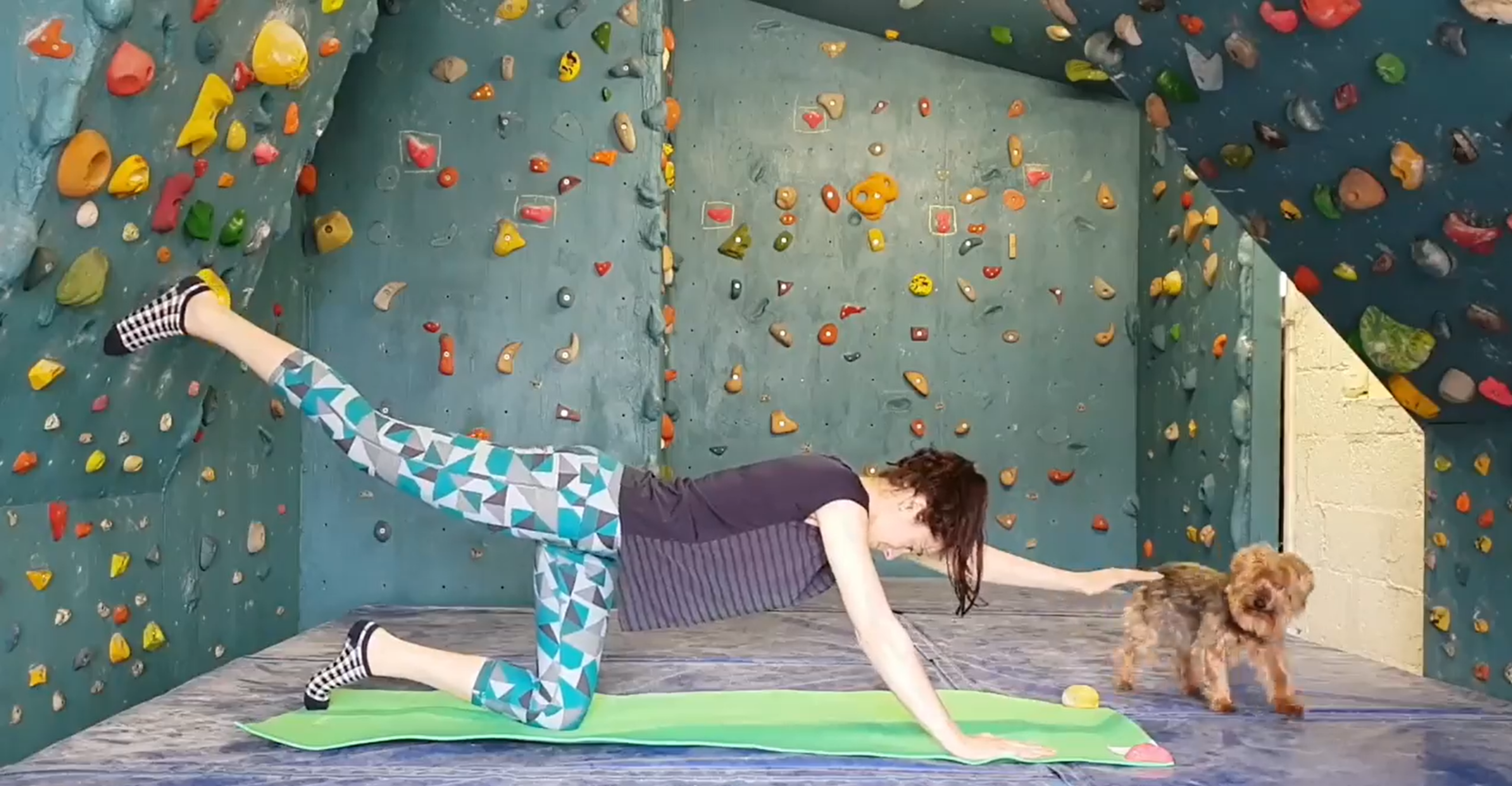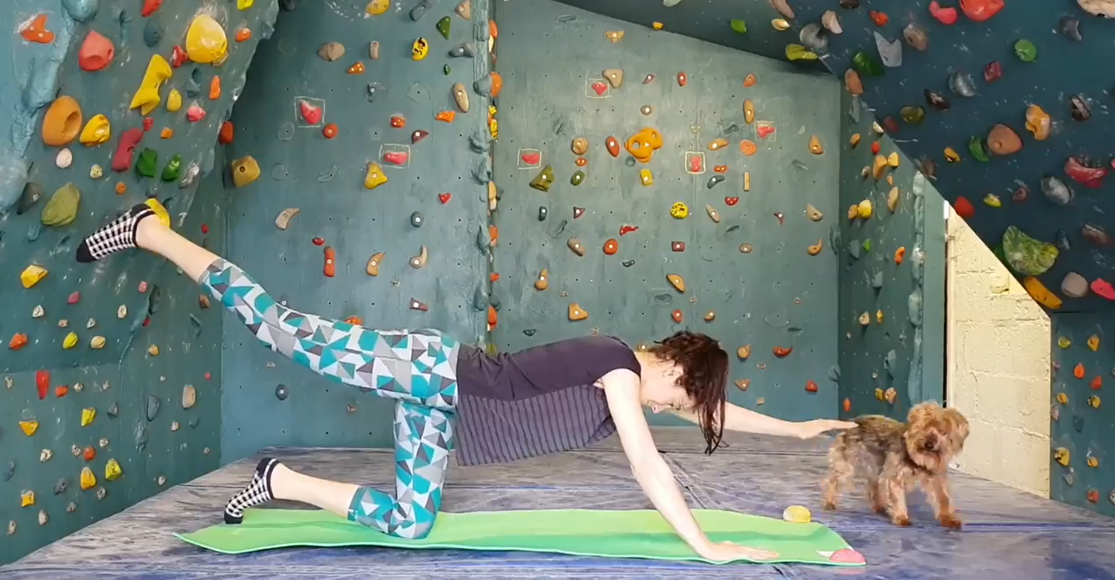Training To Take You From The Office To The Crag | Natalie Berry

Working in a desk (or sofa-) based job can take its toll on the body. I work from home as Editor of UKClimbing.com and spend a lot of time hunched over my laptop or curled on the sofa with it! I've had a few work-related injuries and pain in my hips, back and wrists over the years, but since starting a daily low intensity conditioning 'workout' in 2018 I've managed to stay in better condition.
To try and keep my body in decent working order for climbing, every evening I do a short routine of exercises focused on the back, core, hips and legs to keep the muscles in these areas engaged and flexible after long periods of sitting. Our back and core muscles are generally relaxed or awkwardly strained when sitting with poor posture, so doing some core and back exercises after work helps to keep both sets of muscles balanced and to keep the spine mobile. Our hips and legs can become tight and achey from sitting awkwardly, so some stretching and mobility exercises are key to keeping muscles and joints supple.
This isn't intended to be a strenuous workout, it's simply a basic set of conditioning exercises that I do to offset the neglect/damage done during the day. Of course, we could learn to sit well and try standing desks, but we all know how hard it is to get out of bad habits and standing desks aren't practical for everyone.
Here are the 12 exercises and some pointers, some of which are easy pilates/yoga exercises. I'm not a fitness/pilates instructor, so my form will be off (especially when my dog walks in shot!), but they are straightforward exercises and you can watch videos online from more qualified people!
I generally run through them all as one routine rather than doing lots of sets of each exercise, and it made demonstrating this video more straightforward. Start by practising each exercise individually to gauge how many reps (and sets if you want to push it harder) would work for you. I never aim to feel exhausted during this routine - I just want to feel like I've done something gently physical and it's usually quite relaxing.
An extra, specific stretch for wrists/forearms/elbows: typing with your hands in an awkward arced position can make your forearm extensor muscles tight and lead to tennis elbow or general inflammation in the forearm or repetitive strain injury. Hold an outstretched arm in front of you, palms facing down. Pull down on the back of your hand and you should feel a stretch along the top of the forearm. Rotate your elbow side to side slowly while holding your hand to increase the stretch. Hold until the tightness eases and repeat a few times for each arm.
Exercises in order of appearance:
Spine Peels (back)
Like on your back and slowly lift your spine off the floor in a wave-like motion, starting with the coccyx and 'peeling' each vertebra off the mat until you reach your shoulder blades, then lower, vertebra by vertebra.
This exercise keeps your spine mobile and can ease any back stiffness after sitting.
Dead Bugs (core)
Lie on your back and place your hand under the lower back to make sure there's a gap between your lower back and the mat (neutral spine position). Raise your arms and bent legs above you, and send each opposing limb away from your body at the same time, before returning to the same 'table top' position and switching sides. I do about 20 reps (10 each side)
V Lowers (core)
Keep your back in the same position as for dead bugs, with a gap between your lower back and the mat. Start in 'table top' with your arms and bent legs above you, then send both sets of limbs away from the body, then contract and bring them back to the start position. Keeping your legs straight as you push them out will make it harder (my legs aren't very straight in the video!) I do about 15-120 reps.
Hamstring Pulses (legs)
Still lying on your back, raise both knees and straighten one leg up into the air until you feel a stretch, then release and straighten again quickly. This is a dynamic stretch, which can be more effective than holding a position for a long time. I do about 15 each side.
Forward Leans (legs and hips)
This is another dynamic stretch for the hamstrings and hips. Lean forward trying to touch your toes and 'pulse' where you feel the stretch, moving back and forth. Try and bend from the hips and keep your back straight.. My upper back is a bit too bent forward in the video! I do about 15 pulses each side.
Groin stretch (legs and hips)
Sit with your feet in front of you and let your knees fall to the sides. You should feel a tight stretch! I am quite flexible in this stretch, so others might not be able to get their knees to touch the mat. Pulse your knees a bit or get a friend to push your knees down for a greater stretching benefit! Hold to a point where you feel a bearable stretch and maintain for 30 seconds.
Thoracic Rotations (back)
This exercise improves your mobility in the spine. Sit with your legs crossed with your hands on your shoulders. Twist slowly from side to side, keeping your shoulders facing forward. Try to keep your head facing forward, too (I was a bit distracted by my dog!) Get someone to gently push you from the point where you feel you can't rotate further
Supermans (back)
These are the opposite of Dead Bugs and strengthen the back. Start on all fours, reach one arm and the opposite leg out, hold for 3 seconds, then return to all fours and repeat for the opposing limbs. You might notice a weakness on one side which affects your balance (my left arm leading is clearly less stable, but I also had a dog distraction...)
Cat Stretch (back)
Start on all fours with your hands directly below your shoulders and your knees below your hips. Slowly arch your back upwards (like a cat stretching!) and then slowly lower into a curved spine position. You will probably feel the most movement/raising in the upper back (see the 'hunch' that appears in my back in the video). To stretch the lower back, try and pull your hips in and move some 'sack' down to the lower (lumbar) region of the spine. Repeat 10 times, doing 5 of each position.
Hip Flexor Stretch (hips)
Start with hands shoulder width apart as though you're about to do press-ups, but bring a leg forward and place your knee between your hands and angle your bent front leg at 90 degrees, with your heel by your groin. Lower down and sit with a straight back leg and shift from side to side trying to touch your opposing hand with each shoulder. This exercise stretches the hip flexors and can be painful if you're tight in this area - start gently! Swap legs and do the other side. I do about 20 reps for each leg.
Press-ups/Child's Pose (triceps, back)
There are different types of press-ups. I generally go narrow to focus on triceps for antagonistic training (pushing rather than pulling, which I do a lot more of while climbing!) rather than wider ones for shoulders, but you can choose which type you want to focus on - there are loads online! My lower back bends too much in the video - try to keep your back straight! After a set of 5 I lower into child's pose (yoga position) and do so lat stretches by curving my arms to either side and pulsing to get a stretch.
Cobras/Child's Pose (back, hips)
A yoga position. Start on all fours and straighten your legs behind you and push your torso up while keeping your hands shoulder-width apart. Your back will arch, hold for 15 seconds. This works the mid to lower back and increases flexibility in the back and hips. I relax back into child's pose again between these, but you can also simply lower your torso to the floor and push up from there to repeat.
Featured Clothing
Silhouette Women's Tee
A close fitting crop top for total freedom of movement on all-out, on-sight attempts.
View Now
Cala Women’s Crop Legging
Soft and stretchy calf length leggings for total mobility and comfort during long training sessions.
View Now
Find more of our top clothing picks for training and preparing for big mountain days in our training collections
View Women's
 USA
USA United Kingdom
United Kingdom Germany
Germany

